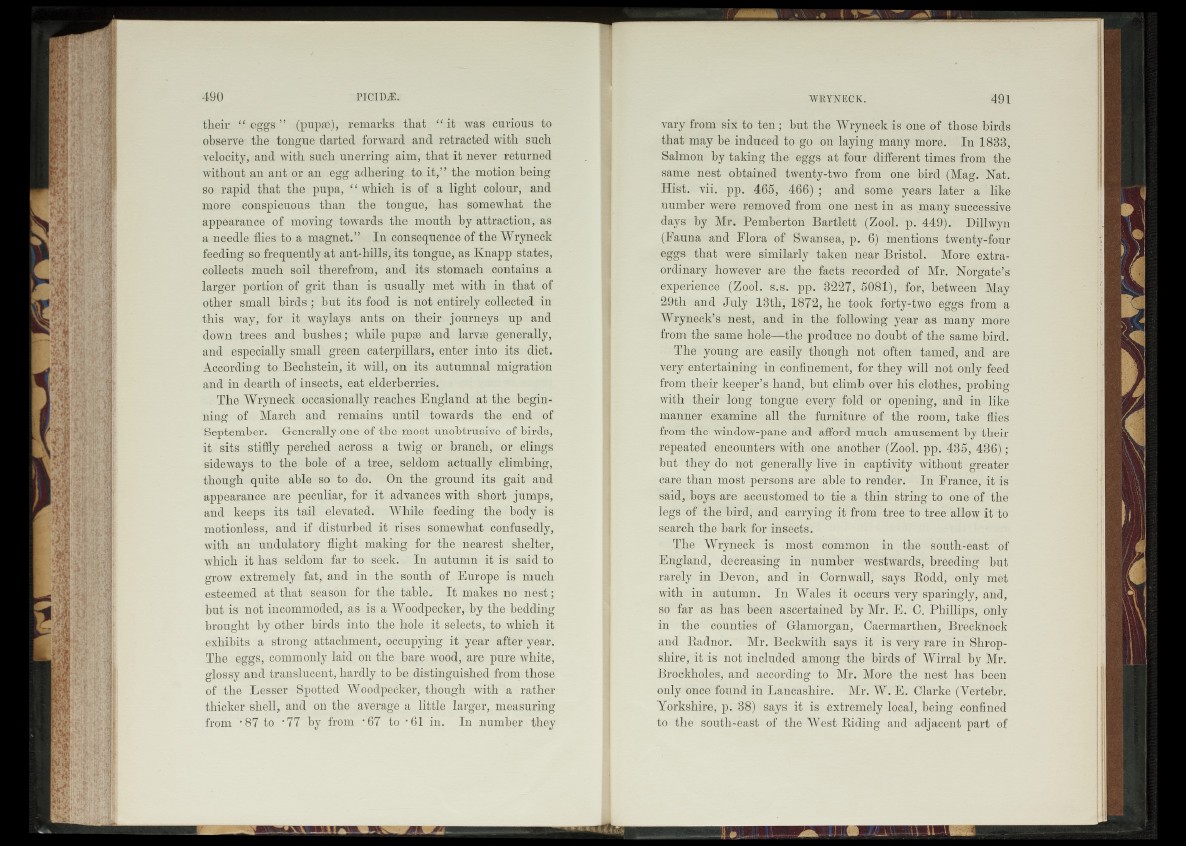
their “ eggs” (pup*), remarks that “ it was curious to
observe the tongue darted forward and retracted with such
velocity, and with such unerring aim, that it never returned
without an ant or an egg adhering to it,” the motion being
so rapid that the pupa, “ which is of a light colour, and
more conspicuous than the tongue, has somewhat the
appearance of moving towards the mouth by attraction, as
a needle flies to a magnet.” In consequence of the Wryneck
feeding so frequently at ant-hills, its tongue, as Knapp states,
collects much soil therefrom, and its stomach contains a
larger portion of grit than is usually met with in that of
other small birds ; but its food is not entirely collected in
this way, for it waylays ants on their journeys up and
down trees and hushes; while pup* and larv* generally,
and especially small green caterpillars, enter into its diet.
According to Bechstein, it will, on its autumnal migration
and in dearth of insects, eat elderberries.
The Wryneck occasionally reaches England at the beginning
of March and remains until towards the end of
September. Generally one of the most unobtrusive of birds,
it sits stiffly perched across a twig or branch, or clings
sideways to the bole of a tree, seldom actually climbing,
though quite able so to do. On the ground its gait and
appearance are peculiar, for it advances with short jumps,
and keeps its tail elevated. While feeding the body is
motionless, and if disturbed it rises somewhat confusedly,
with an undulatory flight making for the nearest shelter,
which it has seldom far to seek. In autumn it is said to
grow extremely fat, and in the south of Europe is much
esteemed at that season for the table. It makes no nest;
but is not incommoded, as is a Woodpecker, by the bedding
brought by other birds into the hole it selects, to which it
exhibits a strong attachment, occupying it year after year.
The eggs, commonly laid on the bare wood, are pure white,
glossy and translucent, hardly to be distinguished from those
of the Lesser Spotted Woodpecker, though with a rather
thicker shell, and on the average a little larger, measuring
from ‘87 to '77 by from "67 to ’ 61 in. In number they
vary from six to ten ; but the Wryneck is one of those birds
that may be induced to go on laying many more. In 1888,
Salmon by taking the eggs at four different times from the
same nest obtained twenty-two from one bird (Mag. Nat.
Hist. vii. pp. 465, 466) ; and some years later a like
number were removed from one nest in as many successive
days by Mr. Pemberton Bartlett (Zool. p. 449). Dillwyn
(Fauna and Flora of Swansea, p. 6) mentions twenty-four
eggs that were similarly taken near Bristol. More extraordinary
however are the facts recorded of Mr. Norgate’s
experience (Zool. s.s. pp. 3227, 5081), for, between May
29th and July 13th, 1872, he took forty-two eggs from a
Wryneck’s nest, and in the following year as many more
from the same hole—the produce no doubt of the same bird.
The young are easily though not often tamed, and are
very entertaining in confinement, for they will not only feed
from their keeper’s hand, but climb over his clothes, probing
with their long tongue every fold or opening, and in like
manner examine all the furniture of the room, take flies
from the window-pane and afford much amusement by their
repeated encounters with one another (Zool. pp. 435, 436);
but they do not generally live in captivity without greater
care than most persons are able to render. In France, it is
said, boys are accustomed to tie a thin string to one of the
legs of the bird, and carrying it from tree to tree allow it to
search the bark for insects.
The Wryneck is most common in the south-east of
England, decreasing in number westwards, breeding but
rarely in Devon, and in Cornwall, says Rodd, only met
with in autumn. In Wales it occurs very sparingly, and,
so far as has been ascertained by Mr. E. C. Phillips, only
in the counties of Glamorgan, Caermarthen, Brecknock
and Radnor. Mr. Beckwith says it is very rare in Shropshire,
it is not included among the birds of Wirral by Mr.
Brockholes, and according to Mr. More the nest has been
only once found in Lancashire. Mr. W. E. Clarke (Vertebr.
Yorkshire, p. 38) says it is extremely local, being confined
to the south-east of the West Riding and adjacent part of